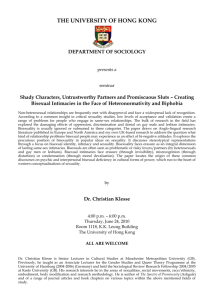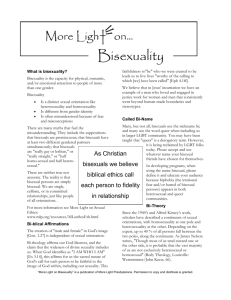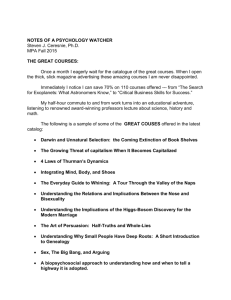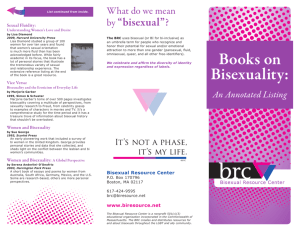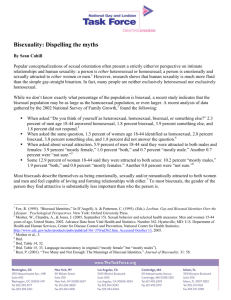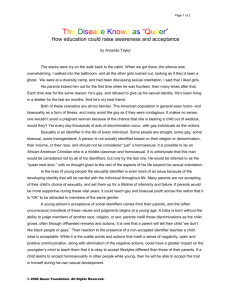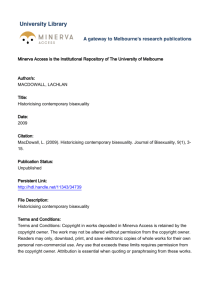Sue George - University of Surrey
advertisement
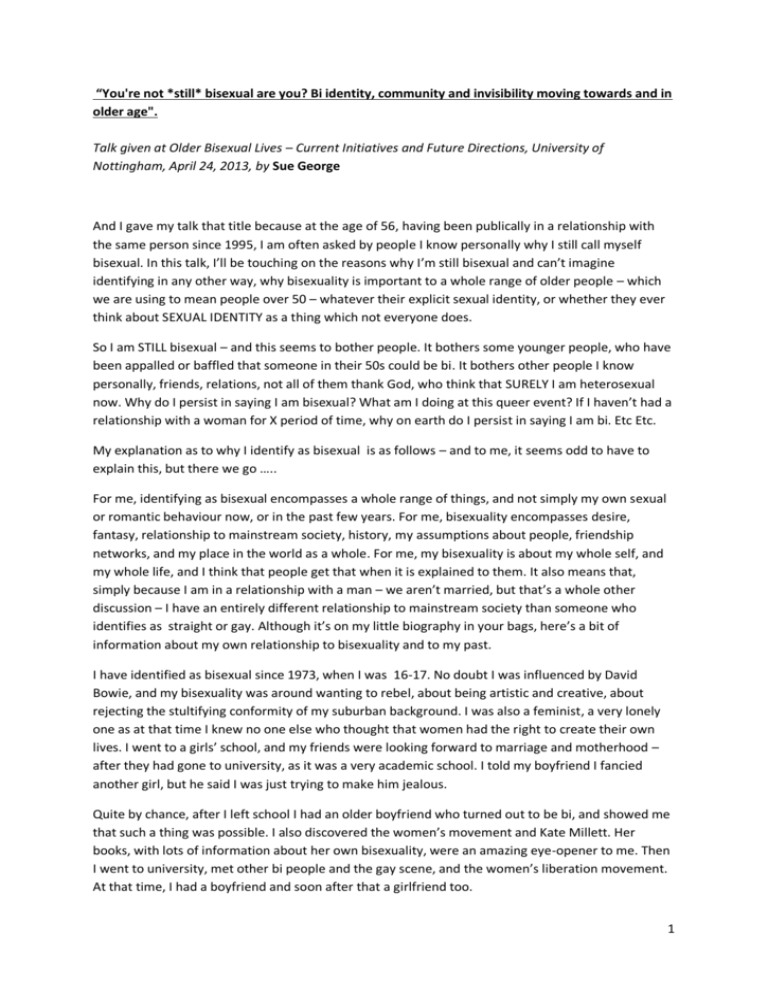
“You're not *still* bisexual are you? Bi identity, community and invisibility moving towards and in older age". Talk given at Older Bisexual Lives – Current Initiatives and Future Directions, University of Nottingham, April 24, 2013, by Sue George And I gave my talk that title because at the age of 56, having been publically in a relationship with the same person since 1995, I am often asked by people I know personally why I still call myself bisexual. In this talk, I’ll be touching on the reasons why I’m still bisexual and can’t imagine identifying in any other way, why bisexuality is important to a whole range of older people – which we are using to mean people over 50 – whatever their explicit sexual identity, or whether they ever think about SEXUAL IDENTITY as a thing which not everyone does. So I am STILL bisexual – and this seems to bother people. It bothers some younger people, who have been appalled or baffled that someone in their 50s could be bi. It bothers other people I know personally, friends, relations, not all of them thank God, who think that SURELY I am heterosexual now. Why do I persist in saying I am bisexual? What am I doing at this queer event? If I haven’t had a relationship with a woman for X period of time, why on earth do I persist in saying I am bi. Etc Etc. My explanation as to why I identify as bisexual is as follows – and to me, it seems odd to have to explain this, but there we go ….. For me, identifying as bisexual encompasses a whole range of things, and not simply my own sexual or romantic behaviour now, or in the past few years. For me, bisexuality encompasses desire, fantasy, relationship to mainstream society, history, my assumptions about people, friendship networks, and my place in the world as a whole. For me, my bisexuality is about my whole self, and my whole life, and I think that people get that when it is explained to them. It also means that, simply because I am in a relationship with a man – we aren’t married, but that’s a whole other discussion – I have an entirely different relationship to mainstream society than someone who identifies as straight or gay. Although it’s on my little biography in your bags, here’s a bit of information about my own relationship to bisexuality and to my past. I have identified as bisexual since 1973, when I was 16-17. No doubt I was influenced by David Bowie, and my bisexuality was around wanting to rebel, about being artistic and creative, about rejecting the stultifying conformity of my suburban background. I was also a feminist, a very lonely one as at that time I knew no one else who thought that women had the right to create their own lives. I went to a girls’ school, and my friends were looking forward to marriage and motherhood – after they had gone to university, as it was a very academic school. I told my boyfriend I fancied another girl, but he said I was just trying to make him jealous. Quite by chance, after I left school I had an older boyfriend who turned out to be bi, and showed me that such a thing was possible. I also discovered the women’s movement and Kate Millett. Her books, with lots of information about her own bisexuality, were an amazing eye-opener to me. Then I went to university, met other bi people and the gay scene, and the women’s liberation movement. At that time, I had a boyfriend and soon after that a girlfriend too. 1 But the lesbian community didn’t like that, and so for a short while I agreed to be a lesbian. Until I met a man, and we decided to have a child. I was quite an active feminist at that time, and when I saw in the London Women’s Liberation Newsletter that a woman was starting a bi women’s group I was thrilled. So I went to my first bi women’s group in 1984 when I was eight months’ pregnant. Throughout the late 80s and early 90s, I was a single mother, going to the bi women’s group and becoming I would say fairly active in the bi community at that time. I went to a lot of meetings anyway! Along with other bi people, we did some low-level HIV prevention work. I also decided to write my book Women and Bisexuality, which was published 20 years ago this month. More about that later I was dating a bit at that time, mainly but not only women and had a longer relationship with a woman in the mid 90s. Then in 1995, my friendship with my current partner turned into a relationship. He doesn’t want to be talked about in public and I respect that. However, my friendship networks are still pretty queer, I still write on bisexuality whenever I can, and am out anywhere and everywhere. I was approached and commissioned to write another book on bisexuality in 2001, but unfortunately the publishers went bust before I could finish the book. Nowadays, I would self-publish without a moment’s thought, but then – although I tried to interest other publishers, they didn’t bite, and I didn’t think that self-publishing was a viable option 12 years ago. So there were lots of interviews that I did with people in around five different countries that never saw the light of day. I began my blog on bisexuality in 2006, partly as a result of this book not being published. But actually blogging is a far better way of getting your ideas out there than is writing a book and hundreds of thousands of people have read the blog. I think and hope I have contributed to bi people’s lives through writing it. Changes in the way bisexuality is seen The way that bisexuality is seen by both mainstream society, the bi community, and the wider queer community, has changed a great deal since I started to say to myself “I am bisexual” 40 years ago. I would say that it was actually more acceptable in the mid-late 70s than it was 10 years later. The gay liberation movement, which I was slightly too young to be involved in, unfortunately, seemed to want to get rid of categories of sexuality and gender, and looked like a lot of fun. But lesbian or gay sexual behaviour was very very much looked down on by mainstream society. In particular, the HIV/Aids epidemic of the early 80s onwards meant that many straight people hated HATED bisexuals, especially but by no means exclusively bisexual men. Many gay men marginalised bi men, many lesbians thought bi women were letting the side down and betraying them. These opinions haven’t gone away, particularly among people who were young at that time. For women, in the early 1990s there was a “sex positive” feminist movement, which meant that women’s – particularly lesbians’ - desires and pleasures were forefronted, butch-femme and BDSM relationships became more accepted and visible. This, to my memory, was a time of terrific arguments in the feminist movement but it did mean that my book Women and Bisexuality came out into a slightly more welcoming environment than I thought it would when I started doing the research for it. 2 In the past 15 years or so, the homophobic laws that had existed in the UK were gradually changed so that gay men now have the same age of consent than heterosexuals, civil partnerships for same sex couples are in law and seem to be popular, drug treatment for people with HIV/Aids has progressed hugely. This is all not just good, but fantastic. Same sex couples holding hands, pushing pushchairs, living their lives in an ordinary way, they can be seen not just in certain parts of certain cities but all over the UK. I’m not saying it’s all perfect, clearly it isn’t, but it is a massive change to 20, 30 or more years ago. But what sort of impact has this had on bisexuality? It’s mixed. As we are at present, there is a strong thrust of opinion – based around some flawed academic research – that says bisexual men don’t exist, which I think is very very hard on bi men whatever age they are. There is another strong thrust of opinion which says that ALL women are bi, because women’s sexuality is more fluid. Sadly, I have not experienced this in my own life. Women might be happy to give you a hug, but that doesn’t morph in any easy way into a sexual relationship. Some significant female pop stars, Jessie J, Lady Gaga, publically identify as bi, which has been good for their fans and for bisexual visibility as a whole. For many people, ideally older people too though this isn’t necessarily the case, the development of social media can be really really helpful in allowing you to express and be at ease with your bisexuality. As far as I see it, the acceptability of bisexuality – whether identity or behaviour – depends very much on where you live and what your support structures are. Anyone who has a casual glance at Twitter will see that young people trying to come out will still face a lot of biphobia from people they thought were their friends. So I bang on about bisexuality at every possible opportunity and I am out in all aspects of my life where it seems remotely appropriate. But still, I see that bisexuals are largely invisibility. While I don’t any more get what I had for years and years – “You’re bisexual?!?!?? I’ve never met anyone who’s bisexual before” and do meet bi people in places that aren’t specifically bi, other bi people OF MY OWN AGE *do* seem to be invisible. And this connects very closely to the reasons why I think the issue of bisexuality and ageing is so important. Invisibility leads to isolation, which leads to poor mental health. It is well known now – by the bi community anyway – that bi people have lower levels of mental health than do lesbians or gay men, certainly than do heterosexuals. If you are isolated, you can’t ask for support when you need it. Important parts of your life may be unknown to people you are close to and, as you get older, to people caring for you. You may feel the lack of other people like you, without really knowing who they are or where they are. There may be some communities for LG older people but bi people not sure of their place there. This may be especially true for lesbians of a particular age. I think this is a good point to mention what someone I spoke to for this talk said: 3 She is 70, has identified as bi for most of her life, and often gives talks to community groups. She said : “I have to contend with the 1970s lesbians, many who still have that separatist edge, and are not very nice and make it clear bisexuals don't belong there or anywhere, "there is no such thing as bi" and they put up with and socialize with the gay men there because there is a generational connection... Humour always works, I was out as a lesbian in the 70s so I know where they're coming from so meet them head on respectfully and I speak to those in the room who are bisexual but who don't feel comfortable coming out etc. AND there are always bisexual people who come up and talk with me and most commonly talk about isolation and not coming to the group much because of the biphobia... the organizers ALWAYS come up to me in SHOCK because they had no idea why these folks only attend once or once in a while. Many in the older generation of GL folks have a lot of old school ideas and haven't been exposed or met younger queers however we name ourselves and don't want to stretch and grow. My hope is this will change as each generation grows in to old/er age.” I hope that too. Bi community So I’m now going to row back a bit and look at the bi community. Or, as I think of them now, the various bi communities that exist in the UK and other places at the moment. The “official” or “political” bi community began in the UK with the London bisexual group in 1981, this started out of anti-sexist men’s groups and met at the gay men’s club Heaven. There were many other groups in the UK in the 1980s and 90s, including Nottingham. I think the mixed London group ended around 15 years ago. There was also a women only group in London from 1984, which lasted until about 10 years ago. These groups were mainly discussion groups and they were very very important to the people who visited them, ESPECIALLY as they were coming out. Nowadays, there are many fewer real-world groups, but there are social Meet-Up groups in London and elsewhere, as well as occasional Bi Fests (informal fun days) and annual BiCons (bisexual national conferences). There are also international conferences and many bi groups in other parts of the world. So who is in this bisexual community and who isn’t? The background in anti-sexist men’s and feminist groups carried on certainly throughout the 90s. The politics has always been generally progressive, with many seeming to be hippies and then later on goths. It has always been a place where gender non-conformity is accepted (to a greater or lesser extent, I’m not saying it’s perfect), where many good things have happened. But there have always been very very few people of colour, and this has been an issue ever since I can remember. It is also a well-educated community and pretty middle class, with very few older people. What does this bi community do? It is a social support network, yes, but it has also done huge amounts of valuable work often in promoting bi issues in lesbian and gay groups, often against an 4 atmosphere of biphobia or writing letters to newspapers on bi issues. This includes the long-running newsletter Bi Community News. But this political bi community is just one bisexual community. Others include swingers (who I’d define for the purposes of this talk as people in opposite sex countries who have casual sex ouyside of that); what is now referred to as the Kink community – fetish clubs. So those communities are connected more specifically to sexual behaviour. Then there is the overall queer community, where there are many individuals who are sexually attracted to, or have relationships with, people of more than one gender. There are also other communities where there are many bi people, such as emos and goths. These communities aren’t discrete entities: people going to fetish clubs might go to BiCon, there are queer emos, and so forth. But there are also many other bi people who would say to people they were intimate with, or to themselves, “I am bisexual” but have no interest in being part of a bi community. Quite a few people have said to me: “why would I want to mix with people simply because we share the same sexuality” and “I do it, what do I want to talk about it for?” Nevertheless, people who think along those lines, along with others who spent their time in the non-political bi communities I’ve just referred to, have benefitted from the hard work of bi activists over the past 30 years. Women and Bisexuality book I started doing the research for Women and Bisexuality in the late 80s, and it was eventually published 20 years ago on Monday [29 April]. I wanted to write it because, firstly, I am a writer and that was, then at least, the way I work through issues in my own life was by writing about them. At that time, bisexuality seemed to me completely invisible. Outside of the bi groups I never met ANYONE who said they were bi, and it was considered to be a step on the way to gay – and nothing else. The book is primarily interview and questionnaire-based: almost 150 women answered questions on sex, love, feminism, their partners, how they felt about bisexuality, their background and history, their hopes for the future. I framed this with an analysis as to why bisexuality was so invisible – basically, because society was (and to a slightly lesser extent still is) divided into straight/good, gay/bad, with bisexuality as a threat to that separation. I want to give two examples here of women who I know something about who saw themselves as bisexual. So they were bisexual throughout their whole lives, and although they are older than anyone we would know now I think looking at their lives is enlightening. One of them died in 2004 at the age of 96, the other was born around 1908 too, but as my knowledge of her was only when I interviewed her for Women and Bisexuality, I don’t know what happened to her after that. First of all Margaret, who I interviewed for my book. She was a civil servant who lived in Chelsea for most of her life, before retiring to Suffolk. She had some casual relationships and unhappy love affairs with women and a longer happier relationship with a married man. She was 78 when I interviewed her, and at that time she had what she described as “a great friend”, a younger woman who had no idea of her feelings. She had felt quite unhappy about her sexuality over much of her 5 life, disliking the Chelsea lesbian community, but felt very much happier about her life at the time I interviewed her. Then there’s Nerina Shute, who I’ve been increasingly fascinated by since I came across her about 10 years ago and whose life formed a substantial part of my MA dissertation. She was a film critic and writer from a very young age. She had difficult love affairs with women, then married her first husband in the late 30s, and her second during the war. They had a very intense love relationship which started to go wrong in the post-period. She had a relationship with their refugee housekeeper and when she confessed to her husband, he left her. Later, she had two long and happy relationships with women. She was explicitly bisexual – ambisextrous as they called it in the 20s. She felt she needed relationships with men and women, and that these relationships were complementary. So bisexuality was always there, and explicitly for some. Other people I asked But what about the experiences of other bi people over 50? I thought I’d ask around. I got nowhere through asking on social media, which I think is interesting in itself, so I asked around bi-identifying people I knew for things they had noticed about being older and bi. What was important to THEM. These are the thoughts of some half a dozen bi people aged between around 51 and 72 gathered together anonymously. Obviously, given that this is such a small number of people, I knew them all, and they all explicitly identified as bisexual, they simply represent a tiny snapshot of some issues. I want to stress right now that, although this sounds a bit doom and gloomy, many felt very positive about their sexualities and lives, feeling that they had lived by their own rules. But that being said, Several things had a BIG impact on how they felt about their sexuality, and this may have more to do with getting older than with sexual identity. Others seemed to be more connected with bisexuality in the sense that they are a straightforward development of what younger bi people experience too. These are: Caring responsibilities, and the impact that had on their life as a whole. This could mean looking after children, but that seemed less demanding than for those who had to look after frail parents or siblings which could mean they had no time to themselves at all that would allow them to look for partners. Then there were issues with their own health, which could make them isolated or unsure about their own attractiveness or abilities as a potential partner. Those two things – their own health and the health of others – meant that other things necessarily took second place. Isolation. They only socialised with people they already knew, which meant that they didn’t meet anyone who they could form relationships with. Alternatively, they only met new people who were much younger and both they, and the younger people, ruled each other out as potential partners. Invisibility. This operates in slightly different ways for men and women. Older people are generally not seen as bisexual, although sometimes bi men can be seen as bi in a very negative way by both women and men – predatory, unattractive, undesirable Dirty Old Men. 6 Older women are generally seen as invisible and certainly not sexual. If by some fluke they ARE sexual, then they become Dirty Old Women. This may be slightly less true within the lesbian community than in mainstream society. Perhaps. Both women and men remarked that they felt less comfortable about their sexual attractiveness and desirability as a partner than they used to. This was particularly the case for those who had experienced significant levels of ill-health. For people who WERE in a long-term relationship, though (and the people I talked to all identified as bi, and were out as bi to their partners) their bisexuality DID have some impact on their relationship over the very long term but they found it hard to pin down what that was. If they were bi and their partner (only one of people I talked to had significant poly relationships at the moment, and they were comparatively new) their partner WASN’T, then they felt there was a part of their lives that they couldn’t share with them and that DID have some kind of impact. Several remarked that they STILL had to come out all the time, that there were presumptions that they were straight / or lesbian / or gay / or simply that they weren’t people with any kind of interesting past as they weren’t married. For some, this coming out had to do with ensuring that new people they met (or indeed, in advance of meeting them) knew that they identified as bisexual and that this was a significant part of their lives. Indeed, for those people who were in couples, especially long-term couples whether of the same or other genders, the invisibility as they were getting older was very striking and this is what I have experienced myself. You are perceived as being the identity that matches the gender of your partner. Thinking about other people I know who might be described as bisexual over their lifespan but for whom sexual identity seems less of a burning issue than it is for me, matching their identity to that of their partner is a very common thing. For instance, a woman I know who is now 57…. She was very heterosexually active as a young woman then got married and had a child in her mid 20s. Then she discovered sex with women, decided she had really been a lesbian all along, and was an extremely enthusiastic lesbian for about 15 years. This was in the mid 80s to 1990s. Then out of the blue she met a man, fell in love, and married him. They have been married for about 12 years now. If you ASKED her, she would say she supposed she was bisexual but it doesn’t really have an impact on her as she has no interest in other relationships. But much of her friendship network is still queer, whereas her husband’s friendship network really isn’t. I know of other women in couple relationships too who say that their bisexuality is only a theoretical issue because they have no interest in other relationships. When I did some research for that book about bisexuality in the early 2000s, I interviewed around 100 people on their sexuality. For that, I found it easy enough to find men who considered themselves bisexual, but not women. This has often puzzled me. But I think that, for SOME women, the post menopause period signals a change in interest towards sex and sexuality. One of the few women who I found for that research said that, post menopause, her interest in sexual or romantic relationships in general had changed and seemed less urgent. She still identified as bisexual. I am loath to hypothesise, particularly as my whole thesis is that sexuality is far far more than actually 7 having any particular relationship RIGHT NOW but it seems odd not to mention that something might be going on…. Difference in ages/generations Different generations may see bisexuality very differently. An 18 year old and a 40 year old, a 30 year old and a 70 year old, are going to see everything about their lives differently. Similarly, although this talk covers bi people over 50, a 50 year old and an 80 year old are also going to be facing very different issues about their sexuality and everything else. I think that bears saying. But there are other things that need saying too. One of the things that I discussed with one of my long-term bisexual friends – he is 71 – is the way that things change and as you get older, one of the challenges is to both realise that they have changed and what they have changed to. The debate shifts and there is no huge public announcement that this has happened. For instance, many young people who in the past might have called themselves bisexual call themselves pansexual . Without Twitter, I would not have known of this term. Trans issues are framed entirely differently to what they were 20 or 30 years ago. I didn’t mention trans once in Women and Bisexuality and there is no way I would do that now. And the word Queer – while for younger people (and me too) a useful political term, and an academic theory, is still something that people in their 70s and 80s remember hearing as an insult. And they hate it as a result. So an older bi person may see their bisexuality as different from a younger one because they grew up thinking of bisexuality in a different way. For instance, in the 1980s I remember bi people were much keener on the idea that men and women were complementary and that as a bisexual you would need to have relationships with a man and a woman contemporaneously. Bi people now generally don’t believe this, and it is often dismissed as one of those myths about bisexuality. But for some people in the past, Nerina Shute, for instance, this was exactly what they DID think. They believed that relationships between women, and relationships between men and women, were totally different. Many bi men, and all the older ones, I interviewed for that never published bi book also felt that relationships between men and women, and men and men were totally, completely different. This, too, may be less true for younger men. So what bisexuality means changes over time, and how an individual relates to their bisexuality also relates to where are in lifespan. In addition, the way bisexuality is viewed by society changes over time. So all of those combined MAY mean that older bi people see their bisexuality very differently to those younger. I think this is all at the very early stages of research and there is so very much we don’t yet know about bisexuality and ageing. I’m sure Rebecca is going to tell us what we DO know in a minute! But in closing, I do want to go back to the title of this talk. Yes, I am STILL bisexual and I think that stressing the importance of identity and community by being out as bisexual if it is at all possible will help us counteract invisibility. That, in turn, will make life easier for all bi people. Thanks 8
